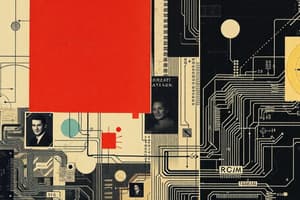Podcast
Questions and Answers
What is the role of ROM BIOS in a computer system?
What is the role of ROM BIOS in a computer system?
ROM BIOS provides essential services like initializing hardware, booting software, and interfacing with peripherals.
How are EEPROMs different from traditional ROMs?
How are EEPROMs different from traditional ROMs?
EEPROMs can be erased one byte at a time, making them more convenient for small-scale programming.
What are some common applications of ROMs?
What are some common applications of ROMs?
ROMs are widely used in system firmware, bootloaders, embedded systems, and security applications.
What are the advantages of ROMs compared to other types of memory?
What are the advantages of ROMs compared to other types of memory?
What are the disadvantages of using ROMs?
What are the disadvantages of using ROMs?
Flashcards are hidden until you start studying
Study Notes
Control Memory: Understanding ROM and Its Role
In the realm of computer systems and information processing, control memory plays a crucial role in ensuring the proper execution of programs and storing essential data. One vital component within control memory that we'll be exploring is ROM (Read-Only Memory).
ROM: A Fixed Reservoir of Data
ROM is a type of non-volatile memory that stores information permanently, unaffected by the loss of power. Its contents are determined during the manufacturing process and remain constant throughout the device's lifespan. ROMs are used for storing firmware, which is software that controls the basic operations of a computer or other electronic device.
ROM Types
There are several types of ROMs, each with their own unique characteristics.
-
Masked ROM (MROM) or Programmable Read-Only Memory (PROM): These types of ROMs have fixed content, which is predetermined during the manufacturing process. Once the content is set, it cannot be altered without replacing or rewriting the chip.
-
Erasable Programmable Read-Only Memory (EPROM): EPROMs are reprogrammable and can be erased using ultraviolet light. However, the erasing process is time-consuming and requires specialized equipment.
-
Electrically Erasable Programmable Read-Only Memory (EEPROM) or Flash Memory: Similar to EPROMs, EEPROMs are reprogrammable. Unlike EPROMs, EEPROMs do not require ultraviolet light or specialized equipment to erase. Instead, they utilize electrical signals to erase data. EEPROMs can be erased one byte at a time, making them more convenient for small-scale programming.
-
ROM BIOS: The Read-Only Memory Basic Input/Output System (ROM BIOS) is a type of firmware that runs when a computer starts, providing essential services such as initializing hardware, booting software, and interfacing with peripherals.
ROM Applications
ROMs are widely used in various applications, including:
-
System firmware: ROMs store firmware that controls the basic operations of a computer or other electronic devices.
-
Bootloaders: ROMs can be used to store bootloaders that load an operating system or other software into memory when a computer starts.
-
Embedded systems: ROMs are used in embedded systems, which are computers designed to perform specific functions in various devices such as automobiles, smartphones, and medical equipment.
-
Security applications: ROMs can be used to store digital certificates, encryption keys, and other sensitive data in a tamper-proof manner.
Advantages and Disadvantages
ROMs have several advantages, such as:
-
Non-volatility: ROMs retain their contents even when power is lost.
-
Fast access: ROMs offer faster access time compared to other types of memory.
-
Reliability: ROMs are more reliable and less prone to errors than other types of memory.
However, ROMs also have some disadvantages:
-
Non-upgradable: ROMs cannot be altered or updated once they are programmed.
-
High cost: ROMs are more expensive per bit than other types of memory.
Conclusion
ROM plays a crucial role in controlling memory and ensuring the proper execution of programs and storing essential data. ROMs are non-volatile memory that stores information permanently and are widely used in various applications, including system firmware, bootloaders, embedded systems, and security applications. Despite their advantages, ROMs have some disadvantages, such as their non-upgradability and high cost. Understanding ROM and its role in control memory is essential for anyone interested in computer systems and information processing.
Studying That Suits You
Use AI to generate personalized quizzes and flashcards to suit your learning preferences.




